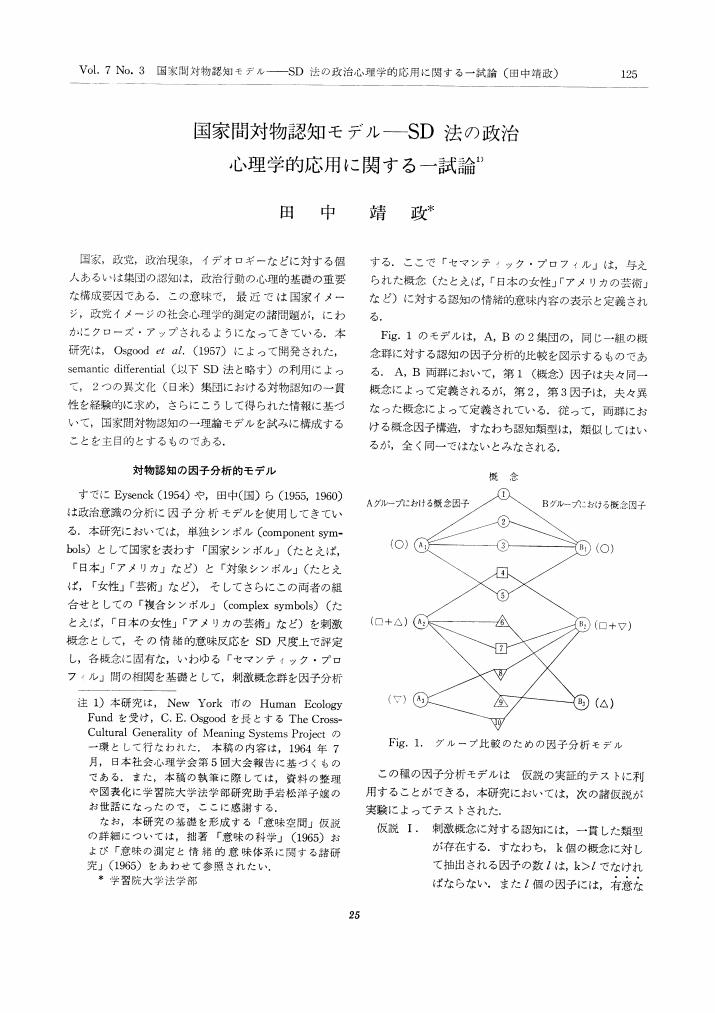- 著者
- 田中 靖政
- 出版者
- 日本マス・コミュニケーション学会
- 雑誌
- 新聞学評論 (ISSN:04886550)
- 巻号頁・発行日
- no.15, pp.129-135, 1966-03-01
1 0 0 0 OA 国家間対物認知モデル SD法の政治心理学的応用に関する一試論
- 著者
- 田中 靖政
- 出版者
- 科学基礎論学会
- 雑誌
- 科学基礎論研究 (ISSN:00227668)
- 巻号頁・発行日
- vol.7, no.3, pp.125-133, 1965-09-15 (Released:2009-09-04)
- 参考文献数
- 15
1 0 0 0 日米学生における色彩感情と色彩象徴
- 著者
- 大山 正 田中 靖政 芳賀 純
- 出版者
- The Japanese Psychological Association
- 雑誌
- 心理学研究 (ISSN:00215236)
- 巻号頁・発行日
- vol.34, no.3, pp.109-121, 1963
- 被引用文献数
- 12 16
This study is an attempt to investigate the affective meaning of 16 colors and 14 symbolic words as judged by Japanese and American subjects and to seek synesthetic correspondence between the colors and the words. Four groups of subjects (Japanese male college students, Japanese female college students, American female highschool students and American famale college students) rated the colors, and two groups of subjects (Japanese and American female college students) judged the words on a 35scale semantic differential. Color cards and semantic scales used, and two of the four color-groups of subjects were the same a those of the factor-analytical study previously reported (<i>Jap. psychol, Res., </i> 1962, 4, 78-91).<br>First, in connection with colors, a good agreement was found among the four subject groups in their judgment of meaning of each color represented by mean scale scores (See Fig. 1-4 in the text). Secondly, it was noted that scales correlating highly with the Munsell Hue were mainly Activity scales (e.g. <i>hot-cold, near-far, womanly-manly, unstable-stable, dangerous-safe, excitablequiet</i>). Scales correlating highly with Value were in the main Potency cales(e.g. <i>heavy-light, deep-shallow, full-empty, hard-soft, tense-relaxed, strong-weak, dry-wet.</i>) Evaluative scales (e.g. <i>beautiful-ugly, good-bad, clear-muddy, fresh-stale, healthy-unhealthy, new-old</i>) appeared to have no such particular correlation with any of the Munsell dimensions. However, colors ranging from Yellow to Blue generally tend to be rated as positive on Evaluative scales(i.e., toward <i>good</i>), whereas colors approaching to and departing from the Purple-Red region tend to be rated negatively (i.e., toward <i>bad</i>). Black and Gray were judged as <i>bad</i> whereas White was rated as <i>good</i>.<br>In connection with the 14 symbolic words, it was discovered first that the factor structures of both Japanese and American <i>Word</i>-spaces were reasonably similar to each other but quite different from the factor structure of the <i>Color</i>-spaces. In the former, the Evaluative factor was most salient while in the latter the Activity was most salient, although three factors-Evaluation, Potency and Activity-were as a group most dominant in each of four concept-culture group. Secondly, on the basis of 15 descriptive scales, 5 for each factor, it was discovered that symbolic words display similar affective meaning to certain colors (Table 2). For example, ANGER and JEALOUSY were found to be closely associated with Red, while SIN and FEAR were related to Black and Purple. ETERNITY, VIRGINITY, and QUIETNESS, on the other hand, were associated with Blue or White, while HAPPINESS, HOME and LOVE with Green. Thirdly, the whole scale profile of each word was correlated with that of each color. Basically similar associative relations were obtained between words and colors, as discovered above.<br>The results obtained in this part of study were in general agreement with results obtained by Obonai and Matsuoka (<i>J. gen. Psychol</i>., 1956, 55, 229-239) who used direct word-color associations to assess the synesthetic relations. Differences between their study and ours were submitted to test in the last part of the present study by asking a new group of subjects to choose a color associate from 16 color-stimuli for each of the concept words, where the colors and words used were the same as in earlier parts of this study. The obtained data confirmed the Obonai-Matsuoka study. In general, it was concluded that the semantic differential provides a useful method for assessing the association between different classes of concepts.

